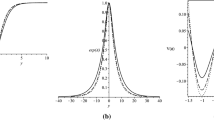Abstract
The mechanism of generation of the Standard Model for fermions on the domain wall in five-dimensional space-time is presented. As a result of self-interaction of five-dimensional fermions and gravity induced by matter fields, in the strong coupling regime, in the model there arises a spontaneous translational symmetry breaking, which leads to localization of light particles on a 3 + 1-dimensional domain wall (“3-brane”) that is embedded into a five-dimensional anti-de Sitter space-time (AdS5). Appropriate low-energy, effective action, classical kink-like vacuum configurations for the gravity and scalar fields are investigated. Mass spectra for light composite particles and their coupling constants interaction in ultra-low-energy, which localize on the brane, are explored. We establish estimates of characteristic scales and constants interactions of the model and also a relation between the bulk five-dimensional gravitational constant, curvature of AdS5 space-time, and brane Newton’s constants. The induced cosmological constant on the brane exactly vanishes in all orders of the theory perturbation. We find out that scalar interaction is strongly suppressed at ultra-low-energy, and the brane fluctuations (branons) are suitable “sterile” canditates for explanation of the phenomenon of Dark Matter. Bibliography: 21 titles.
Similar content being viewed by others
References
V. A. Rubakov and M. E. Shaposhnikov, Phys. Lett., B125, 136 (1983); ibid., B125, 139 (1983); V. A. Rubakov, Usp. Fiz. Nauk, 171, 913 (2001); Usp. Fiz. Nauk, 173, 219 (2003).
K. Akama, Lect. Notes Phys., 176, 267 (1982); hep-th/0001113; M. Visser, Phys. Lett., B159, 22 (1985); hep-th/9910093; N. Arkani-Hamed, S. Dimopoulos, and G. R. Dvali, Phys. Lett., B429, 263 (1998); Phys. Rev., D59, 086004 (1999); I. Antoniadis, N. Arkani-Hamed, S. Dimopoulos, and G. R. Dvali, Phys. Lett., B436, 257 (1998); M. Gogberashvili, Mod. Phys. Lett., A14, 2025 (1999); Int. J. Mod. Phys., D11, 1639 (2002); hep-ph/0001109; L. Randall and R. Sundrum, Phys. Rev. Lett., 83, 3370, 4690 (1999).
V. A. Rubakov, Phys. Usp., 44, 871 (2001); Phys. Usp., 46, 211 (2003).
I. Antoniadis, “Physics with large extra dimensions,” in: High-Energy Physics, Beatenberg (2001), p. 301; hep-th/0102202; S. Forste, Fortsch. Phys., 50, 221 (2002).
Yu. A. Kubyshin, “Models with extra dimensions and their phenomenology,” (2001); hep-ph/0111027; J. Hewett and M. Spiropulu, Ann. Rev. Nucl. Part. Sci., 52, 397 (2002).
R. Dick, Class. Quant. Grav., 18, R1 (2001); D. Langlois, Prog. Theor. Phys. Suppl., 148, 181 (2003); R. Maartens, Living Rev. Rel., 7, 7 (2004); P. Brax, C. van de Bruck, and A. C. Davis, Rept. Prog. Phys., 67, 2183 (2004).
C. P. Burgess, Annals Phys., 313, 283 (2004).
G. Gabadadze, ICTP Lectures on Large Extra Dimensions (2003); hep-ph/0308112.
F. Feruglio, Eur. Phys. J., C33, S114 (2004).
C. Csaki, TASI Lectures on Extra Dimensions and Branes (2004); hep-ph/0404096; T. G. Rizzo, Pedagogical Introduction on Extra Dimensions (2004); hep-ph/0409309.
A. A. Andrianov, V. A. Andrianov, P. Giacconi, and R. Soldati, JHEP, 07, 003 (2005).
O. DeWolfe, D. Z. Freedman, S. S. Gubser, and A. Karch, Phys. Rev., D62, 046008 (2000).
T. Gherghetta and M. E. Shaposhnikov, Phys. Rev. Lett., 85, 240 (2000); M. Laine, H. B. Meyer, K. Rummukainen, and M. Shaposhnikov, JHEP, 01, 068 (2003); JHEP, 04, 027 (2004).
A. A. Andrianov, V. A. Andrianov, P. Giacconi, and R. Soldati, JHEP, 07, 063 (2003).
A. A. Andrianov and L. Bonora, Nucl. Phys., B233, 232 (1984); ibid., B233, 247 (1984).
Ya. B. Zel’dovich, Pis’ma ZETF, 6, 883 (1967); A. D. Sakharov, Dokl. Akad. Nauk SSSR, 177, 70 (1967).
E. G. Adelberger, B. R. Heckel, and A. E. Nelson, Ann. Rev. Nucl. Part. Sci., 53, 77 (2003).
A. Dobado and A. L. Maroto, Nucl. Phys., B592, 203 (2001); J. Alcaraz, J. A. R. Cembranos, A. Dobado, and A. L. Maroto, Phys. Rev., D67, 075010 (2003); J. A. R. Cembranos, A. Dobado, and A. L. Maroto, Phys. Rev., D68, 103505 (2003); Phys. Rev., D70, 096001 (2004).
S. L. Dubovsky, V. A. Rubakov, and P. G. Tinyakov, Phys. Rev., D62, 105011 (2000); S. L. Dubovsky and V. A. Rubakov, Int. J. Mod. Phys., A16, 4331 (2001).
V. A. Miransky, M. Tanabashi, and K. Yamawaki, Phys. Lett., B221, 177 (1989).
W. Pauli, Teoria della Relatività, Boringhieri, Torino (1970), pp. 65–66.
Author information
Authors and Affiliations
Corresponding author
Additional information
Dedicated to the 100th birthday of M. P. Bronstein
__________
Translated from Zapiski Nauchnykh Seminarov POMI, Vol. 347, 2007, pp. 5–29.
Rights and permissions
About this article
Cite this article
Andrianov, A.A., Andrianov, V.A., Giacconi, P. et al. Standard model of fermions on the domain wall in five-dimensional space-time. J Math Sci 151, 2801–2812 (2008). https://doi.org/10.1007/s10958-008-9006-6
Received:
Published:
Issue Date:
DOI: https://doi.org/10.1007/s10958-008-9006-6



